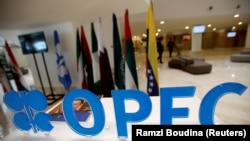Iran has dropped to the bottom of the list of the Organization of Petroleum Exporting Countries' (OPEC) crude exporters, slightly ahead of Gabon and Equatorial Guinea.
Meanwhile, the United States, Saudi Arabia and Russia have retained their position at the top of the global table with producing 14.46, 12.08, and 11.18 barrels of crude per day (bpd), respectively.
The U.S. and Russia are not members of OPEC, an organization composed of fourteen countries.
Based on Radio Farda's data provided by the international intelligence firm, Kpler, Iran's oil exports in November dropped to 213,000 bpd.
Prior to wide-ranging sanctions Washington imposed, Iran was exporting 2.5 million bpd and was the fourth OPEC crude oil producer, behind Saudi Arabia, Iraq, and the United Arab Emirates (UAE.)
Washington imposed sanctions on Tehran's oil exports in November 2018 but granted waivers to eight countries to continue buying limited amounts of oil from Iran until May 2019, when Washington decided not to renew the exemptions.
Iran's oil exports during the first quarter of the current year was nearly one million and 330,000 bpd, on average. However, it significantly dropped since June, decreasing to an average of 346,000 bpd.
Now, Kpler's data show that it has further dropped, decreasing to 213,000 bpd in November.
The drop has occurred at a time that Iran's budget for the current fiscal year (beginning March 21, 2019) is based on exporting more than 1.5 million bpd and for next year 870 bpd.
However, Iranian officials admitted later that the budget had been amended but stopped short of pinpointing the share of oil in the revised version.
Iran's crude oil revenue in 2018 amounted to $60 billion, which was 55% more than the value of the country's non-oil exports.
According to the International Monetary Fund (IMF), Iran's budget deficit in the current year amounts to 8% of the country's GDP. Therefore, Iran will struggle with a nearly $37 million budget deficit.
IMF has also estimated that Iran's budget deficit in 2020 would be equal to nearly 8.1 percent of the country's GDP.
Iran's current government budget is $415 billion, but this is what has been officially announced. The armed forces and intelligence organs, among others, have revenues and expenditures that remain outside of what President Hassan Rouhani's administration manages.
Earlier, the IMF had estimated that Iran is in a severe recession with GDP shrinking 9.5 percent. World Bank estimates also closely match IMF figures.
Nonetheless, the U.S. Special Representative for Iran Brian Hook has challenged IMF's forecast by insisting that Washington believes Iran’s growth rate will be minus 12 percent.
In the meantime, Radio Farda's data provided by Kpler show that Iran's liquid petroleum gas (LPG) export in November also dropped to 343,000 tons. Available data forecasts that Iran's LPG exports will drop further to 300,000 tons in December.






